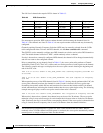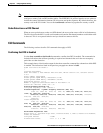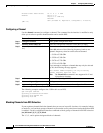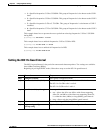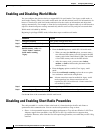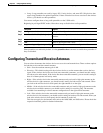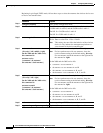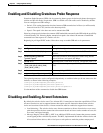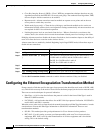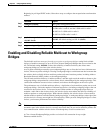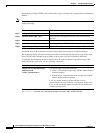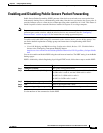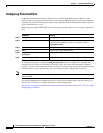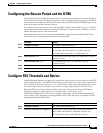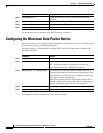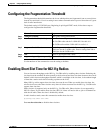
6-26
Cisco IOS Software Configuration Guide for Cisco Aironet Access Points
OL-30644-01
Chapter 6 Configuring Radio Settings
Configuring the Ethernet Encapsulation Transformation Method
• Cisco Key Integrity Protocol (CKIP)—Cisco's WEP key permutation technique based on an early
algorithm presented by the IEEE 802.11i security task group. The standards-based algorithm, TKIP,
does not require Aironet extensions to be enabled.
• Repeater mode—Aironet extensions must be enabled on repeater access points and on the root
access points to which they associate.
• World mode (legacy only)—Client devices with legacy world mode enabled receive carrier set
information from the wireless device and adjust their settings automatically. Aironet extensions are
not required for 802.11d world mode operation.
• Limiting the power level on associated client devices—When a client device associates to the
wireless device, the wireless device sends the maximum allowed power level setting to the client.
Disabling Aironet extensions disables the features listed above, but it sometimes improves the ability of
non-Cisco client devices to associate to the wireless device.
Aironet extensions are enabled by default. Beginning in privileged EXEC mode, follow these steps to
disable Aironet extensions:
Use the dot11 extension aironet command to enable Aironet extensions if they are disabled.
Configuring the Ethernet Encapsulation Transformation Method
Frames contain a field that specifies the upper Layer protocol that should be used (such as IP, IPX, ARP,
etc). This field is necessary at the receiver level to direct the frame properly in the receiver network stack.
There are two main techniques for protocol indication:
• EtherType—A 16 bit value that indicates the protocol carried in the frame. EtherType is used in
Ethernet 2.0/DIX networks.
• LLC/SNAP—A 6 byte header that allows for an 802.2 link layer protocol indication. LLC/SNAP is
used in 802.3 and 802.11 networks.
When the access point receives from the wired network frames that use EtherType information, it needs
a mechanism to convert this EtherType information to SNAP/LLC information. There are two
transformation methods:
• 802.1H—This method provides good performance for Cisco Aironet wireless products.
• RFC 1042—Use this setting to ensure good interoperability with non-Cisco Aironet wireless
equipment. RFC 1042 is used by other manufacturers of wireless equipment and is the default
setting. This is the default setting.
Command Purpose
Step 1
configure terminal Enter global configuration mode.
Step 2
interface dot11radio {0 | 1slot/port
}
Enter interface configuration mode for the radio interface. The
2.4-GHz radio is radio 0, and the 5-GHz radio is radio 1.
The 802.11n 2.4-GHz radio is radio 0
The 802.11n 5-GHz radio is radio 1.
Step 3
no dot11 extension aironet Disable Aironet extensions.
Step 4
end Return to privileged EXEC mode.
Step 5
copy running-config startup-config (Optional) Save your entries in the configuration file.



